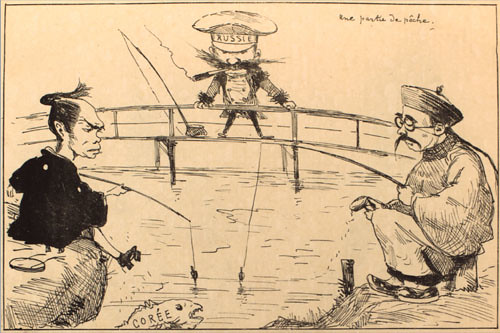 |
| Image 1: Une partie de peche |
Introduction
Do you know this picture (1)? –Yes. Then, do you know about Bigot? -Probably, the answer is ‘No.’. Georges Ferdinand Bigot is a famous French painter who drew a lot of pictures about Japan. His drawings have historic value, and they are included in a history textbook in Japan. That’s why many people might know his works, even if they don’t know Bigot.
Personal history
Bigot was born in Paris. His father was a government official, and his mother was a famous artist. Under the influence of his mother, Bigot was interested in pictures since he was small. When he was 12 years old, he entered the École des Beaux-Arts and studied art until 1876. After he quit his study, he began to work as an illustrator. His work went well, and he gradually became famous. However, when he went to Exposition Universelle de Paris, he was attracted by Ukiyoe (Japanese woodblock prints - Ed), and also by Japan, and finally decided to go to Japan. First, he came to Japan as a oyatoi gaikokujin (a hired foreign expert - Ed), and earned money by teaching art at school. After his employment contract as a oyatoi gaikokujin expired, he began work as a News painter. He reported many disasters with his paintings, and earned a lot of money. Using his salary, he began to publish the comic magazine called TÔBAÉ. In this magazine, he drew a lot of satirical drawings, and created new style of cartoon. He lived in Japan for about 17 years, and came back to France in 1899.
 |
| Georges Ferdinand Bigot |
We discussed two points of Bigot’s accomplishments:
1. If he had been born in different time, Bigot should have decided to settle down in Japan.
-Do you agree or disagree with this opinion?
2. He loved Japan so much, drew a lot about Japanese culture, and also married Japanese woman.
-Why do you think Bigot continued to criticize Japan in his publication?
At first, I asked why Bigot chose to go back to France. In my opinion, Bigot would have stayed in Japan if he was born now. At that time, Japan was gradually becoming more chaotic. For foreigners in Japan, it was extremely dangerous to continue staying in Japan. Many group members agreed with me. In addition, one group member said that if he was born now, he would not become famous. I strongly agree with this opinion. It was fortunate that he was born in the late 19th century because this time period made him famous.
The second question was about Bigot’s character. Through his life, Bigot kept criticizing Japan in his works. However, he also left a lot of episodes to make people think that he loved Japan. Which is his real opinion? In my group, almost all members mentioned that Bigot loved Japan, and because of that, he wanted Japan to grow up more by continuing to point out weak points and problems. I also agree with my group members. If he really hated Japan, I think, he would have not continued staying in Japan for 17 years.
Reflection on person and project
Before this project, I knew Bigot’s works in the same way as majority of people, but did not know well about Bigot. However, while I checked him, I became interested in Bigot. I think Bigot is a Japanophile. He loved Japan so much that he tried to settle down in Japan. However, he didn't do that, and came back to France. This was because he had a lot of difficulties staying in Japan. While he was living in Japan, Japan had two wars, the Sino-Japanese war and the Russo-Japanese war. In this period, foreigners in Japan were sometimes treated badly. Bigot was afraid of Japanese militarism. In addition, he did not get along well with Kuroda Seiki, an authority on the Japanese art. From these facts, he decided to go back to France.
Bigot’s works are important historical materials to know the common customs at that time. They are not only satirical drawings, but also drawings of Japanese daily life. He brought Western style of cartoon to Japan, and also criticized Japanese society with foreigner’s eyes.
I think that it is his misfortune to have been born at this time. If Bigot had been born in different time, maybe his life might have changed.
References
“Georges Ferdinand Bigot”. (n.d.). In Wikipedia, accessed December 2014:
http://ja.wikipedia.org/wiki/%E3%82%B8%E3%83%A7%E3%83%AB%E3%82%B8%E3%83%A5%E3%83%BB%E3%83%93%E3%82%B4%E3%83%BC
Shimizu, I. 2001. Bigot ga mita Nihonjin [Japanese people as seen by Bigot]. Tokyo: Kodansha
Shimizu, I. 2006. Bigot ga mita Meiji Nippon [Meiji Japan as seen by Bigot]. Tokyo: Kodansha







